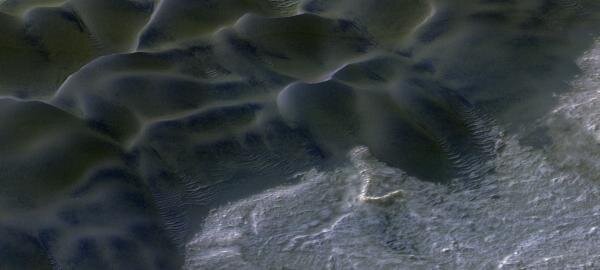
There are wind-driven bedforms on the surface of Earth and Mars. This perspective view shows megaripples at the bottom of the center next to the north polar sand dunes using data from the High Resolution Imaging Science Experiment. The northern polar megaripples and dunes have the highest sand fluxes on the planet. The view is 1 kilometer wide. Credit: HiRISE digital terrain model. NASA/JPL/University of Arizona have HiRISE data.
Megaripples, intermediate-scale bedforms caused by the action of the wind, have been studied extensively and thought to be largely inactive relics of past climates. A new paper by Matthew Chojnacki, a research scientist at the Planetary Science Institute, shows that there are abundant megaripple populations on Mars and that they migrate with dunes and ripples.
Megaripples on Mars are about 1 to 2 meters tall and have 5 to 40 meter spacing, where their size falls between ripples that are 40 centimeters tall with 1 to 5 meter spacing and dunes that can reach hundreds of meters in height. The megaripples' migration rates are slow in comparison, but some of the ripples were found to migrate an average equivalent of 9.6 meters per year over just 22 days in the summer. The megaripple activity is explained by the high rates of sand movement.
We looked at the activity of polar bedforms using repeat HiRISE images. We found that the thin Martian atmosphere can mobilize some coarse-grained megaripples, which overturns previous notions that these were static landforms from a past climate. The most expansive collection of dune fields on Mars is mapped by Chojnacki and his team in the Journal of Geophysical Research: Planets.
There are polar bedform sites with active megaripples. The direction of transport is to the left and the width is 100 meters. The data is from NASA/JPL/University of Arizona.
The long, cold polar winter that covers the region in carbon dioxide and water ice is part of the uncertainty when studying planetary polar landforms. For wind-driven bedforms, such as megaripples, that means they are unable to migrate for nearly half the year. The late spring and summer winds that descend off the polar cap make up for the other periods of inactiveness.
Megaripples were found to be widespread across the region and moving at high rates relative to other sites on Mars that are at lower latitudes. The increased activity is likely related to the greater sand fluxes found for neighboring dunes which are driven by summer-time seasonal winds when polar ice is sublimating. The idea that a lot of the Martian surface is being modified is supported by this. Chojnacki said. Other megaripples seem to be stable, likely due to inter-granular ice within low wind areas.
Matthew Chojnacki and his colleagues have published Widespread Megaripple Activity Across the North Polar Erg of Mars. The DOI is 10.1029/JE006970.
The Journal of Geophysical Research: Planets has information.
There was widespread megaripple activity found on the north pole of the planet.
The document is copyrighted. Any fair dealing for the purpose of private study or research cannot be reproduced without written permission. The content is not intended to be used for anything other than information purposes.